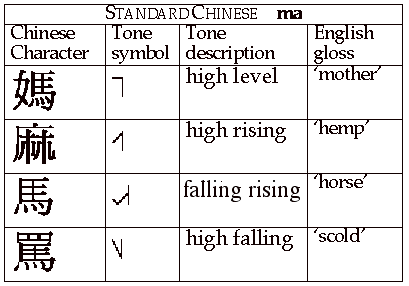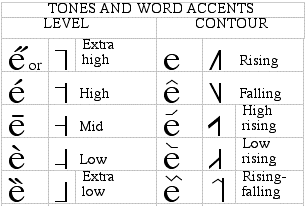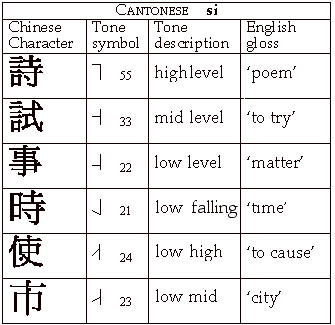2. Pitch and loudness
Section 2. Tones
2.1. The tones of Standard Chinese.
The tones of Standard Chinese. To hear the sounds press Play

The IPA system of tone letters used above represents 5 levels within the speaker’s pitch range, numbered 1 to 5, with 5 being the highest. The analysis shown gives a traditional description of the Chinese tones as said on these words, spoken in isolation. The first tone is said to have the values 55, the second is said to be 35, the third 214, and the fourth 51. If you are using sciconWeb or theWebPlayer or any other system that gives a graphical display of the pitch while you are listening to sounds on the web, you will see that it would be more accurate for this speaker on this occasion to say that the first tone is 44, the second 24, the third 212, and the fourth 52.
Deciding on the transcription is made more complicated by the fact that the IPA Chart provides terms that are not easily applied to this data. It also recognizes two systems for transcribing tones, as shown by the excerpt from the IPA chart below.

Using terms such as those in these columns, it might be said that the four Chinese tones could be described as being (for this speaker, on this occasion): (1) high, (2) mid high (or high rising), mid extra-low mid, and extra high falling. Other similar descriptions would also be possible. It is important to realize that there is no one correct answer to this problem. A transcription is a description in terms of symbols for categories. The way to produce a more precise account of the phonetic realization of tone is to present pitch (and intensity) curves.
2.2. The tones of Cantonese.
The tones of Cantonese. To hear the sounds press Play

Section 2.2 English intonation.
Click on each sentence to hear it.
2.3. I'm going away said as a normal unemphatic statement.
2.4. Where are you going? said as a normal unemphatic question.
2.5. Are you going home? again said as a regular question.
2.6. Where are you going? said with a rising pitch.
2.7. Are you going away? said with some alarm.
2.8. When danger threatens your children, call the police.
2.9. When danger threatens, your children call the police.2.10. Jenny gave Peter instructions to follow.
2.11. Jenny gave Peter instructions to follow.
2.12. An utterance in which there are no words, but in which the speaker sounds contented.
2.13 An utterance in which there are no words, but in which the speaker sounds upset or angry.
Video of the vocal folds
The vibrating vocal folds
(compare figure 2.14 and 2.15)

Photographs of the vocal folds producing a sound at three different pitches
(compare figure 2.16)
 |
 |
 |
120 Hz |
160 Hz |
200 Hz |

